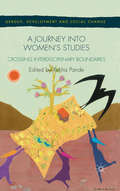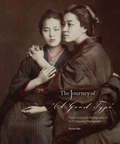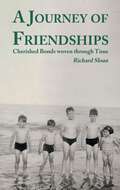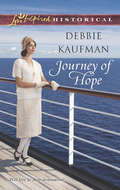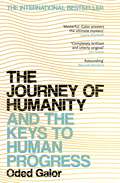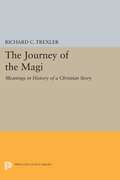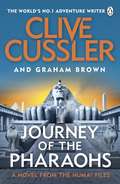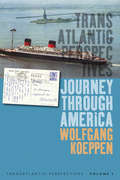- Table View
- List View
Journey Back to God: Origen on the Problem of Evil (AAR Academy Series)
by Mark S.M. ScottJourney Back to God explores Origen of Alexandria's creative, complex, and controversial treatment of the problem of evil. It argues that his layered cosmology functions as a theodicy that deciphers deeper meaning beneath cosmic disparity. Origen asks: why does God create a world where some suffer more than others? On the surface, the unfair arrangement of the world defies theological coherence. In order to defend divine justice against the charge of cosmic mismanagement, Origen develops a theological cosmology that explains the ontological status and origin of evil as well as its cosmic implications. Origen's theodicy hinges on the journey of the soul back to God. Its themes correlate with the soul's creation, fall and descent into materiality, gradual purification, and eventual divinization. The world, for Origen, functions as a school and hospital for the soul where it undergoes the necessary education and purgation. Origen carefully calibrates his cosmology and theology. He portrays God as a compassionate and judicious teacher, physician, and father who employs suffering for our amelioration. Journey Back to God frames the systematic study of Origen's theodicy within a broader theory of theodicy as navigation, which signifies the dynamic process whereby we impute meaning to suffering. It unites the logical and spiritual facets of his theodicy, and situates it in its third-century historical, theological, and philosophical context, correcting the distortions that continue to plague Origen scholarship. Furthermore, the study clarifies his ambiguous position on universalism within the context of his eschatology. Finally, it assesses the cogency and contemporary relevance of Origen's theodicy, highlighting the problems and prospects of his bold, constructive, and optimistic vision.
Journey Back to God: Origen on the Problem of Evil (AAR Academy Series)
by Mark S.M. ScottJourney Back to God explores Origen of Alexandria's creative, complex, and controversial treatment of the problem of evil. It argues that his layered cosmology functions as a theodicy that deciphers deeper meaning beneath cosmic disparity. Origen asks: why does God create a world where some suffer more than others? On the surface, the unfair arrangement of the world defies theological coherence. In order to defend divine justice against the charge of cosmic mismanagement, Origen develops a theological cosmology that explains the ontological status and origin of evil as well as its cosmic implications. Origen's theodicy hinges on the journey of the soul back to God. Its themes correlate with the soul's creation, fall and descent into materiality, gradual purification, and eventual divinization. The world, for Origen, functions as a school and hospital for the soul where it undergoes the necessary education and purgation. Origen carefully calibrates his cosmology and theology. He portrays God as a compassionate and judicious teacher, physician, and father who employs suffering for our amelioration. Journey Back to God frames the systematic study of Origen's theodicy within a broader theory of theodicy as navigation, which signifies the dynamic process whereby we impute meaning to suffering. It unites the logical and spiritual facets of his theodicy, and situates it in its third-century historical, theological, and philosophical context, correcting the distortions that continue to plague Origen scholarship. Furthermore, the study clarifies his ambiguous position on universalism within the context of his eschatology. Finally, it assesses the cogency and contemporary relevance of Origen's theodicy, highlighting the problems and prospects of his bold, constructive, and optimistic vision.
The Journey Home: The Journey Home Family Of The Heart (Mills And Boon Historical Ser.)
by Linda FordIndulge your fantasies of delicious Regency Rakes, fierce Viking warriors and rugged Highlanders. Be swept away into a world of intense passion, lavish settings and romance that burns brightly through the centuries What unseen h guided Kody Douglas's horse to that bleak, windswept South Dakota farmhouse?
Journey into Barbary: Travels across Morocco
by Wyndham LewisIn the spring and summer of 1931, Wyndham Lewis travelled to the westernmost part of the Berber heartland in Morocco, known traditionally as 'Barbary'. Wanting to avoid what he called 'the Baedekered blight' of Anglo-American tourism, he set out for the majestic High Atlas mountains with pens and watercolours to record, in words and images, the rich traditional culture and changing face of the wild, isolated Berber tribes who carved a harsh life out of Morocco's remotest regions. The result is a blend of two arts, the literary skill of a detached and humorous observer, mixed with the drawings of one of the 20th century's most exciting and original artists. Through the eyes of a creative genius, Journey into Barbary is both an inimitable portrait of Morocco and one of the first truly modern accounts of a country that had for so long remained an enigma to generations of travellers.
Journey into the Land of the Zeks and Back: A Memoir of the Gulag
by Julius MargolinUnder the Soviet regime, millions of zeks (prisoners) were incarcerated in the forced labor camps, the Gulag. There many died of starvation, disease, and exhaustion, and some were killed by criminals and camp guards. In 1939, as the Nazis and Soviets invaded Poland, many Polish citizens found themselves swept up by the Soviet occupation and sent into the Gulag. One such victim was Julius Margolin, a Pinsk-born Jewish philosopher and writer living in Palestine who was in Poland on family matters. Margolin's Journey into the Land of the Zeks and Back offers a powerful, first-person account of one of the most shocking chapters of the violent twentieth century. Opening with the outbreak of World War II in Poland, Margolin relates its devastating impact on the Jews and his arrest and imprisonment in the Gulag system. During his incarceration from 1940 to 1945, he nearly died from starvation and overwork but was able to return to Western Europe and rejoin his family in Palestine. With a philosopher's astute analysis of man and society, as well as with humor, his memoir of flight, entrapment, and survival details the choices and dilemmas faced by an individual under extreme duress. Margolin's moving account illuminates universal issues of human rights under a totalitarian regime and ultimately the triumph of human dignity and decency. This translation by Stefani Hoffman is the first English-language edition of this classic work, originally written in Russian in 1947 and published in an abridged French version in 1949. Circulated in a Russian samizdat version in the USSR, it exerted considerable influence on the formation of the genre of Gulag memoirs and was eagerly read by Soviet dissidents. Timothy Snyder's foreword and Katherine Jolluck's introduction contextualize the creation of this remarkable account of a Jewish world ravaged in the Stalinist empire--and the life of the man who was determined to reveal the horrors of the gulag camps and the plight of the zeks to the world.
Journey into the Land of the Zeks and Back: A Memoir of the Gulag
by Julius MargolinUnder the Soviet regime, millions of zeks (prisoners) were incarcerated in the forced labor camps, the Gulag. There many died of starvation, disease, and exhaustion, and some were killed by criminals and camp guards. In 1939, as the Nazis and Soviets invaded Poland, many Polish citizens found themselves swept up by the Soviet occupation and sent into the Gulag. One such victim was Julius Margolin, a Pinsk-born Jewish philosopher and writer living in Palestine who was in Poland on family matters. Margolin's Journey into the Land of the Zeks and Back offers a powerful, first-person account of one of the most shocking chapters of the violent twentieth century. Opening with the outbreak of World War II in Poland, Margolin relates its devastating impact on the Jews and his arrest and imprisonment in the Gulag system. During his incarceration from 1940 to 1945, he nearly died from starvation and overwork but was able to return to Western Europe and rejoin his family in Palestine. With a philosopher's astute analysis of man and society, as well as with humor, his memoir of flight, entrapment, and survival details the choices and dilemmas faced by an individual under extreme duress. Margolin's moving account illuminates universal issues of human rights under a totalitarian regime and ultimately the triumph of human dignity and decency. This translation by Stefani Hoffman is the first English-language edition of this classic work, originally written in Russian in 1947 and published in an abridged French version in 1949. Circulated in a Russian samizdat version in the USSR, it exerted considerable influence on the formation of the genre of Gulag memoirs and was eagerly read by Soviet dissidents. Timothy Snyder's foreword and Katherine Jolluck's introduction contextualize the creation of this remarkable account of a Jewish world ravaged in the Stalinist empire--and the life of the man who was determined to reveal the horrors of the gulag camps and the plight of the zeks to the world.
A Journey into Women's Studies: Crossing Interdisciplinary Boundaries (Gender, Development and Social Change)
by Rekha PandeThe present book is a journey of many women across the world who have struggled to give women's studies visibility. Drawing upon the contributors' diverse experiences and concerns, it explores the metamorphosis of women's studies from the early days to date.
The Journey Matters: Twentieth-Century Travel in True Style
by Jonathan GlanceyWhat was it really like to take the LNER's Art Deco Coronation streamliner from King's Cross to Edinburgh, to cross the Atlantic by the SS Normandie, to fly with Imperial Airways from Southampton to Singapore, to steam from Manhattan to Chicago on board the New York Central's 20th Century Limited or to dine and sleep aboard the Graf Zeppelin? In the course of The Journey Matters, Jonathan Glancey travels from the early 1930s to the turn of the century on some of what he considers to be the most truly glamorous and romantic trips he has ever dreamed of or made in real life.Each of the twenty journeys allows him to explore the history of routes taken, and the events - social and political - enveloping them. Each is the story of the machines that made these journeys possible, of those who shaped them and those, too, who travelled on them.
The Journey of "A Good Type": From Artistry to Ethnography in Early Japanese Photographs
by David OdoWhen Japan opened its doors to the West in the 1860s, delicately hand-tinted photographic prints of Japanese people and landscapes were among its earliest and most popular exports. David Odo studies the collection of Japanese photographs at Harvard’s Peabody Museum and the ways they were produced, acquired, and circulated in the nineteenth century.
The Journey of Deacon Bodo from the Rhine to the Guadalquivir: Apostasy and Conversion to Judaism in Early Medieval Europe
by Frank RiessThe story of Bodo begins in the ninth century around the time of the death of Charlemagne in 814. It centres on a young Aleman aristocrat and his conversion to Judaism in 838, followed by his flight to the Muslim world of Al-Andalus. His apostasy constitutes an arresting footnote in the history of the Carolingian period, his change of faith viewed as a shocking episode attributed by some to an overly lax policy towards Judaism and its powerful merchants. Another factor could be ascribed to the study of Judaism and its links with Christianity, which was a feature of the time. Bodo moved from a monastery on the Rhine, where he went as a small boy, to the imperial court, where he was now a gifted young scholar groomed for a top position. His unexpected abandonment of Christianity challenged his background and learning, and this was seen as a rebuke of the court network to which he belonged. Bodo left behind a growing conflict over succession between the emperor, Louis the Pious, and his sons that culminated in a civil war following the emperor’s death. As a result, the Frankish Empire was partitioned into three separate kingdoms in 843. Meanwhile in Spain, two years after fleeing the Frankish world, Bodo debated the merits of Judaism and Christianity in Córdoba with Albarus Paulus, a beleaguered Christian in the Muslim world, not only airing criticisms of Christianity, but also some failings of the Carolingian imperial court. In 847 he is mentioned in the court annals as stirring up opposition in Islamic Spain against Christians, asserting that they should be forced to convert or be executed. This reported incident may be linked to a significant number of self-imposed deaths by Christians who, feeling increasingly persecuted, sought to provoke Islam by denouncing the Prophet and bringing about their execution. The experience of Bodo’s apostasy was far from unique: other men and women who renounced Christianity for Judaism are also examined in conversion narratives recorded in the following two centuries. These episodes offer an illuminating study of religious changes taking place in Europe and the East where Christianity, Islam and Judaism competed in the ninth century and beyond. Bodo’s experience can be viewed as part of a wider phenomenon depicting men and women who travelled as pilgrims, refugees or converts seeking to find a home and escape persecution because of their beliefs.
The Journey of Deacon Bodo from the Rhine to the Guadalquivir: Apostasy and Conversion to Judaism in Early Medieval Europe
by Frank RiessThe story of Bodo begins in the ninth century around the time of the death of Charlemagne in 814. It centres on a young Aleman aristocrat and his conversion to Judaism in 838, followed by his flight to the Muslim world of Al-Andalus. His apostasy constitutes an arresting footnote in the history of the Carolingian period, his change of faith viewed as a shocking episode attributed by some to an overly lax policy towards Judaism and its powerful merchants. Another factor could be ascribed to the study of Judaism and its links with Christianity, which was a feature of the time. Bodo moved from a monastery on the Rhine, where he went as a small boy, to the imperial court, where he was now a gifted young scholar groomed for a top position. His unexpected abandonment of Christianity challenged his background and learning, and this was seen as a rebuke of the court network to which he belonged. Bodo left behind a growing conflict over succession between the emperor, Louis the Pious, and his sons that culminated in a civil war following the emperor’s death. As a result, the Frankish Empire was partitioned into three separate kingdoms in 843. Meanwhile in Spain, two years after fleeing the Frankish world, Bodo debated the merits of Judaism and Christianity in Córdoba with Albarus Paulus, a beleaguered Christian in the Muslim world, not only airing criticisms of Christianity, but also some failings of the Carolingian imperial court. In 847 he is mentioned in the court annals as stirring up opposition in Islamic Spain against Christians, asserting that they should be forced to convert or be executed. This reported incident may be linked to a significant number of self-imposed deaths by Christians who, feeling increasingly persecuted, sought to provoke Islam by denouncing the Prophet and bringing about their execution. The experience of Bodo’s apostasy was far from unique: other men and women who renounced Christianity for Judaism are also examined in conversion narratives recorded in the following two centuries. These episodes offer an illuminating study of religious changes taking place in Europe and the East where Christianity, Islam and Judaism competed in the ninth century and beyond. Bodo’s experience can be viewed as part of a wider phenomenon depicting men and women who travelled as pilgrims, refugees or converts seeking to find a home and escape persecution because of their beliefs.
A Journey of Friendships: Cherished Bonds woven through Time
by Richard SloanThe themes running through the book are friends and friendships. It is not an academic study of friendship. It is about the relationships with some of the people the author has encountered during his life. Readers will be able to define for themselves whom they regard as good, best, close etc. friends. This book should act as a catalyst for them to arrive at these definitions. The book shows how the class ceiling was broken by his liberal thinking parents, university education and marriage. He made deep interclass friendships. He was brought up with a live-in nanny, housekeeper, gardener etc. His mother was brought up old money and upper class in Germany. Several of his friends are professors and the human sides of these and those who taught him are demonstrated. His friendship and love of Frank, his brother, a merchant navy radio officer, resulted in his love of the sea and cruising with his parents and friends. During the pandemic lockdowns of 2020/21, his garden became a friend. His relationship with the garden was a major factor in preventing loneliness and depression. Social therapeutic gardens. A significant involvement with science in his early life supplied him with an enquiring mind and involved deep working relationships with fellow scientists. Some of the scientific work undertaken jointly with his PhD supervisor, W R Keatinge, as described. Was he a friend? Since his wife died in 2015, social media and electronic means of communicating have kept him in close touch with friends and others. The evolution and some history of these modes of communication used by the author over 50 years and are described. He was actively in politics in the earl 1980s. Political work creates friendships and camaraderie amongst campaigners.
The Journey of G. Mastorna: The Film Fellini Didn't Make
by Federico FelliniFederico Fellini’s script for perhaps the most famous unmade film in Italian cinema, The Journey of G. Mastorna (1965/6), is published here for the first time in full English translation. It offers the reader a remarkable insight into Fellini’s creative process and his fascination with human mortality and the great mystery of death. Written in collaboration with Dino Buzzati, Brunello Rondi, and Bernardino Zapponi, the project was ultimately abandoned for a number of reasons, including Fellini’s near death, although it continued to inhabit his creative imagination and the landscape of his films for the rest of his career. Marcus Perryman has written two supporting essays which discuss the reasons why the film was never made, compare it to the two other films in the trilogy La Dolce Vita and 8½, and analyze the script in the light of It’s a Wonderful Life and Fredric Brown’s sci-fi novel What Mad Universe. In doing so he opens up an entire world of connections to Fellini’s other films, writers and collaborators. It should be essential reading for students and academics studying Fellini’s work.
Journey of Hope (Mills & Boon Love Inspired Historical): Claiming The Cowboy's Heart Lone Wolf's Lady The Wyoming Heir Journey Of Hope
by Debbie KaufmanMARRIAGE IS NOT HER MISSION
The Journey of Humanity: The Origins of Wealth and Inequality
by Oded GalorA radically uplifting account of our species' progress, from one of the world's pre-eminent thinkers - with breakthrough insights into the power of diversity and our capacity to tackle climate change.'Completely brilliant and utterly original ... a book for our epoch' Jon Snow, former presenter Channel 4 News'Astounding in scope and insight ... provides the keys to the betterment of our species' Nouriel Roubini, author of Crisis Economics'A masterful sweep through the human odyssey ... if you liked Sapiens, you'll love this' Lewis Dartnell, author of Origins____What are the keys to human progress?Why are living standards so unequal around the world?How might all humans thrive and survive?In The Journey of Humanity, Oded Galor offers a revelatory explanation of how humanity became, only very recently, the unique species to have escaped a life of subsistence poverty, enjoying previously unthinkable wealth and longevity. He reveals why this process has been so unequal around the world, resulting in the great disparities between nations that exist today. He shows why so many of our efforts to improve lives have failed and how they might succeed.____'An engaging and optimistic answer to anyone who thinks that poverty and inequality will always be with us' Ian Morris, author of Why the West Rules - For Now'Breathtakingly ambitious' Robert Solow, Nobel Laureate in Economics'Magisterial' Glenn C. Loury, author of The Anatomy of Racial Inequality
The Journey of Man: A Genetic Odyssey
by Spencer WellsAround 200,000 years ago, a man--identical to us in all important respects--lived in Africa. Every person alive today is descended from him. How did this real-life Adam wind up father of us all? What happened to the descendants of other men who lived at the same time? And why, if modern humans share a single prehistoric ancestor, do we come in so many sizes, shapes, and races? Showing how the secrets about our ancestors are hidden in our genetic code, Spencer Wells reveals how developments in the cutting-edge science of population genetics have made it possible to create a family tree for the whole of humanity. We now know not only where our ancestors lived but who they fought, loved, and influenced. Informed by this new science, The Journey of Man is replete with astonishing information. Wells tells us that we can trace our origins back to a single Adam and Eve, but that Eve came first by some 80,000 years. We hear how the male Y-chromosome has been used to trace the spread of humanity from Africa into Eurasia, why differing racial types emerged when mountain ranges split population groups, and that the San Bushmen of the Kalahari have some of the oldest genetic markers in the world. We learn, finally with absolute certainty, that Neanderthals are not our ancestors and that the entire genetic diversity of Native Americans can be accounted for by just ten individuals. It is an enthralling, epic tour through the history and development of early humankind--as well as an accessible look at the analysis of human genetics that is giving us definitive answers to questions we have asked for centuries, questions now more compelling than ever.
Journey of no return?: Narrative der Rückkehr im Kontext von Gewalt und Vertreibung im 20. und 21. Jahrhundert (Exil-Kulturen #6)
by Jasmin CentnerDiese literaturwissenschaftliche Studie beschäftigt sich mit Rückkehrerzählungen, denen eine gewaltvolle Vertreibung vorausliegt. Erfahrungen der erzwungenen Entortung und der anschließenden Rückkehr prägen nicht nur die Handlung von Texten, sondern wirken sich auch auf die Ästhetik der Narrationen aus. Die acht untersuchten Erzähltexte (u.a. von Anna Seghers, Abbas Khider, Peter Weiss, Primo Levi, Herta Müller und Doron Rabinovici) befragen (Un-)Möglichkeiten der Rückkehr aus unterschiedlichen Perspektiven. Texte, die vor dem Hintergrund der nationalsozialistischen Vertreibungspolitik entstanden sind, werden mit aktuellen Erzählungen in Verbindung gesetzt. In vier thematischen Sektionen (u.a. Rückkehr aus dem Exil, aus dem Lager sowie nach Palästina/Israel) wird gezeigt, dass die Rückkehr in unterschiedlichen Kontexten ähnliche Erzählmuster hervorbringt sowie Vorstellungen von Heimat und Ursprünglichkeit problematisiert
The Journey of the Magi: Meanings in History of a Christian Story
by Richard C. TrexlerMatthew's Gospel reveals little about the three wealthy visitors said to have presented gifts to the infant Jesus. Yet hundreds of generations of Christians have embellished that image of the Three Kings or Magi for a myriad of social and political as well as spiritual purposes. Here Richard Trexler closely examines how this story has been interpreted and used throughout the centuries. Biblically, the Journey of the Magi presents a positive image of worldly power, depicting the faithful in progress toward their God and conveying the importance of the gift-giving laity as legitimators of their deity. With this in mind, Trexler explains in particular how Western societies have molded the story to describe and augment their own power--before the infant God and among themselves.The author demonstrates how the magi as a group functioned in Christian society. For example, magi plays, processions, and images taught people how to pray and behave in reverential contexts; they featured monarchs and heads of republics who enacted the roles of the magi to legitimate their rule; and they constrained native Americans to fall in line behind the magi to instill in them loyalty toward the European world order. However, Trexler also shows these philosopher-kings as competitive among each other, as were groups of different ages, races, and genders in society at large. Originally modeled on representations of the Roman triumphs, the magi have reached the present day as street children wearing crowns of cardboard, proving again the universality of the image for constructing, reinforcing, and even challenging a social hierarchy.Originally published in 1997.The Princeton Legacy Library uses the latest print-on-demand technology to again make available previously out-of-print books from the distinguished backlist of Princeton University Press. These editions preserve the original texts of these important books while presenting them in durable paperback and hardcover editions. The goal of the Princeton Legacy Library is to vastly increase access to the rich scholarly heritage found in the thousands of books published by Princeton University Press since its founding in 1905.
Journey of the Pharaohs: Numa Files #17 (The NUMA Files #15)
by Clive Cussler Graham BrownTHE LATEST NOVEL FROM THE NO. 1 SUNDAY TIMES BESTSELLING MASTER OF ADVENTURE CLIVE CUSSLER 'Twists that will make even hardcore adventure fans say "wow!" This is fast-paced, nonstop fun. Cussler fans will gobble it up' - Kirkus (Starred Review) Kurt Austin and the NUMA crew risk everything to stop a cutthroat arms dealer from stealing a priceless ancient treasure. In 1074 B.C., vast treasures disappear from the tombs of Egyptian Pharaohs. In 1927, a daredevil American aviator vanishes on an attempted transcontinental flight. And in the present day, a fishing trawler - along with its mysterious cargo - sinks off the coast of Scotland.How are these three mysterious events connected?And, more importantly, what do they mean for Kurt Austin and his NUMA team?Kurt and his team soon find themselves wrapped up in a treacherous treasure hunt as they race to find the lost Egyptian riches. . . before they fall into the wrong hands.Other titles in The NUMA Files series include Final Option, The Oracle and The Titanic Secret. Praise for Clive Cussler 'The Adventure King' Sunday Express 'Cussler is hard to beat' Daily Mail 'Nobody does it better... nobody!' Stephen Coonts
The Journey of William of Rubruck to the Eastern Parts of the World, 1253-55: As Narrated by Himself. With Two Accounts of the Earlier Journey of John of Pian de Carpine (Hakluyt Society, Second Series)
by William Woodville RockhillThe texts of Willem van Ruusbroec and Giovanni da Pian del Carpine, translated from the Latin and edited, with an Introductory Notice. See also Second Series 173. This is a new print-on-demand hardback edition of the volume first published in 1900.
The Journey of William of Rubruck to the Eastern Parts of the World, 1253-55: As Narrated by Himself. With Two Accounts of the Earlier Journey of John of Pian de Carpine (Hakluyt Society, Second Series)
by William Woodville RockhillThe texts of Willem van Ruusbroec and Giovanni da Pian del Carpine, translated from the Latin and edited, with an Introductory Notice. See also Second Series 173. This is a new print-on-demand hardback edition of the volume first published in 1900.
Journey Out of Darkness: The Real Story of American Heroes in Hitler's POW Camps--An Oral History (Praeger Security International)
by Hal LaCroix Jorg MeyerJourney Out of Darkness is a poignant collection of portraits, in words and photographs, of 19 former prisoners of war who bravely endured captivity in Nazi Germany in World War II. Through these men, one can learn essential truths about the POW experience during that war—truths that counter many popular myths and misconceptions. The men featured here gather every week in offices of the Veterans Administration in Boston and Brockton, Mass. to talk about their experiences and find comfort in each other. In their eighties and nineties, they are unique individuals with unique wartime experiences, but also representative of the more than 120,000 American POWs held in Nazi Germany. They are men who fought a double war, in combat and then as POWs. Using both oral histories and photographs to tell their stories, LaCroix and Meyer humanize a terrifying aspect of war, redefining how we think about these men as POWs, survivors, patriots, and members of the Greatest Generation.Journey Out of Darkness is a poignant collection of portraits, in words and photographs, of 19 former prisoners of war who bravely endured captivity in Nazi Germany during World War II. Through these men, one can learn essential truths about the POW experience during that war—truths that counter many popular myths and misconceptions.The 19 men featured here gather every week in offices of the Veterans Administration in Boston and Brockton, Mass., to talk about their experiences and find comfort in each other. In their eighties and nineties, they are unique individuals with unique wartime experiences, but also representative of the more than 120,000 American POWs held in Nazi Germany. They are men who fought a double war, in combat and then as POWs. Together, their photos and their stories go beyond typical first-person accounts.Until the men in this book began meeting in VA support groups, few had spoken of their POW experiences. Some were told by the military not to talk; others were coerced by military intelligence into signing non-disclosure papers called security certificates. With little exception, they received no recognition for enduring as POWs, even as they struggled with traumatic memories and shame for having been held captive, for losing power over their fate, and for surviving combat when friends died. These portraits also illuminate another little-known story: the plight of Jewish-American POWs. Two of the men featured in the book were Jews who concealed their religious identities from the SS.LaCroix and Meyer have crafted a powerful exploration of the struggles of these brave veterans. Using both oral histories and photographs, Journey Out of Darkness humanizes a terrifying aspect of war, redefining how we think about these men as POWs, survivors, patriots, and members of the Greatest Generation.
Journey Through America (Transatlantic Perspectives #1)
by Wolfgang Koeppen Michael KimmageAmerikafahrt by Wolfgang Koeppen is a masterpiece of observation, analysis, and writing, based on his 1958 trip to the United States. A major twentieth-century German writer, Koeppen presents a vivid and fascinating portrait of the US in the late 1950s: its major cities, its literary culture, its troubled race relations, its multi-culturalism and its vast loneliness, a motif drawn, in part, from Kafka’s Amerika. A modernist travelogue, the text employs symbol, myth, and image, as if Koeppen sought to answer de Tocqueville’s questions in the manner of Joyce and Kafka. Journey through America is also a meditation on America, intended for a German audience and mindful of the destiny of postwar Europe under many Americanizing influences.
Journey through Mathematics: Creative Episodes in Its History
by Enrique A. González-VelascoThis book offers an accessible and in-depth look at some of the most important episodes of two thousand years of mathematical history. Beginning with trigonometry and moving on through logarithms, complex numbers, infinite series, and calculus, this book profiles some of the lesser known but crucial contributors to modern day mathematics. It is unique in its use of primary sources as well as its accessibility; a knowledge of first-year calculus is the only prerequisite. But undergraduate and graduate students alike will appreciate this glimpse into the fascinating process of mathematical creation.The history of math is an intercontinental journey, and this book showcases brilliant mathematicians from Greece, Egypt, and India, as well as Europe and the Islamic world. Several of the primary sources have never before been translated into English. Their interpretation is thorough and readable, and offers an excellent background for teachers of high school mathematics as well as anyone interested in the history of math.
A Journey Through Ruins: The Last Days of London
by Patrick WrightA unique evocation of Britain at the height of Margaret Thatcher's rule, A Journey Through Ruins views the transformation of the country through the unexpected prism of every day life in East London. Written at a time when the looming but still unfinished tower of Canary Wharf was still wrapped in protective blue plastic, its cast of characters includes council tenants trapped in disintegrating tower blocks, depressed gentrifiers worrying about negative equity, metal detectorists, sharp-eyed estate agents and management consultants, and even Prince Charles. Cutting through the teeming surface of London, it investigates a number of wider themes: the rise and dramatic fall of council housing, the coming of privatization, the changing memory of the Second World War, once used to justify post-war urban development and reform but now seen as a sacrifice betrayed. Written half a century after the blitz, the book reviews the rise and fall of the London of the post-war settlement. It remains one of the very best accounts of what it was like to live through the Thatcher years.




